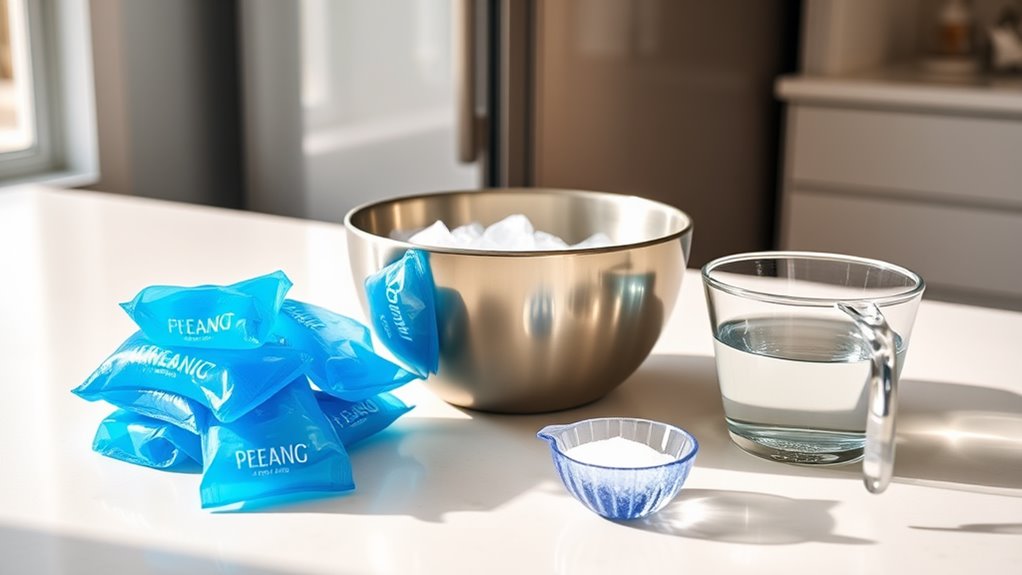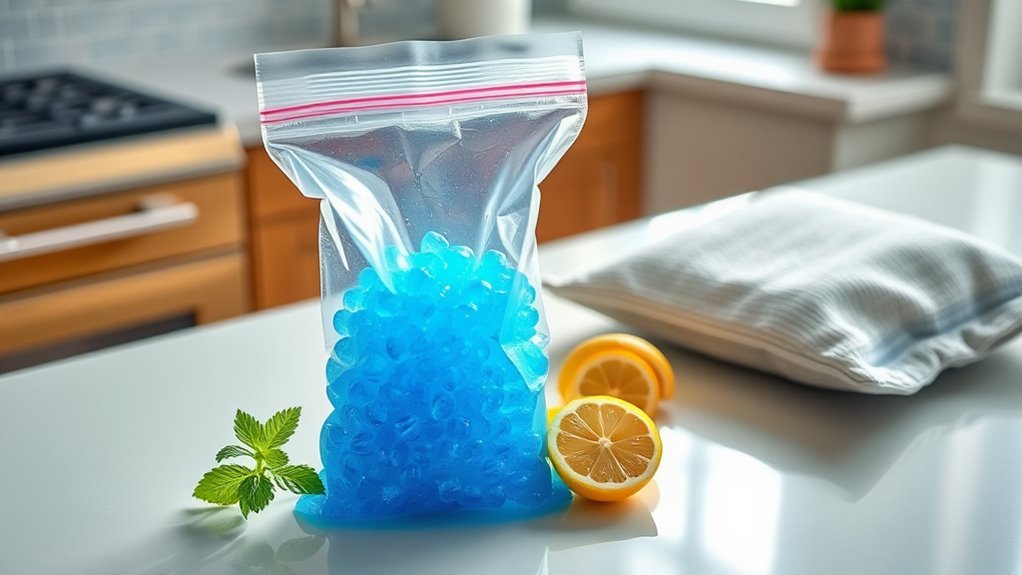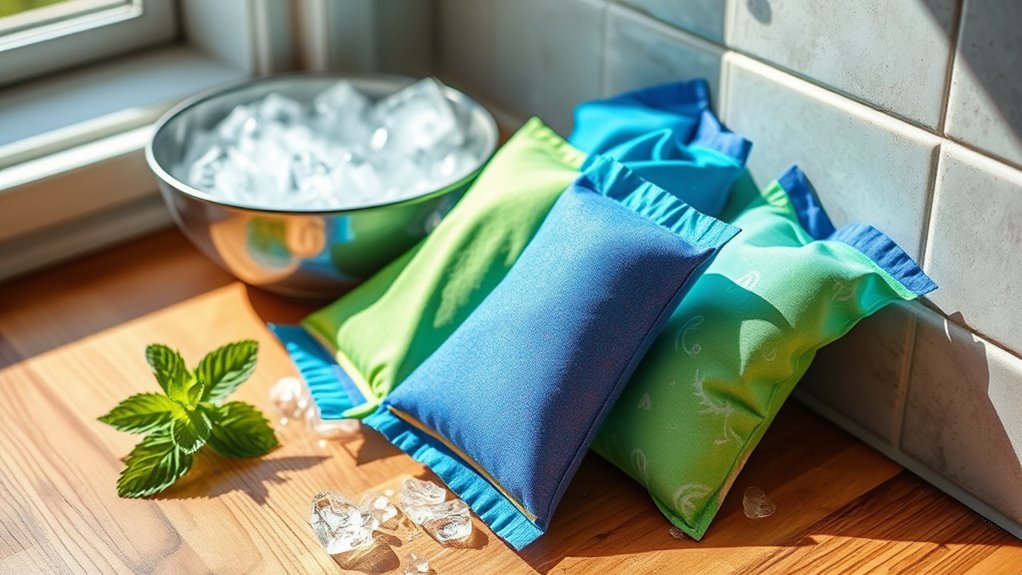How to Make Ice Packs That Stay Cold Longer!
To make ice packs that stay cold longer, mix rubbing alcohol or dish soap with water; this keeps the pack flexible and enhances cold retention. You can also use a salt-water mixture, which lowers the freezing point. Pour your chosen mix into a zip-lock bag, seal it tightly, and freeze for several hours. For even better results, wrap the pack in a towel to slow heat transfer. Discover more tips and tricks to enhance your ice pack experience.
Understanding the Science of Cold Retention
When you think about making ice packs, it’s important to understand how cold retention works. Cold retention relies on the ability of materials to absorb and hold low temperatures for extended periods.
This process involves thermal conductivity, which is how well a substance can transfer heat. Materials with low thermal conductivity, like gel or certain salts, can slow down the heat transfer, keeping your ice pack cold longer.
Additionally, the volume and surface area of your ice pack impact its efficiency. A larger surface area allows for more heat absorption, while a compact design can minimize exposure to warmer air.
Best Ingredients for Homemade Ice Packs
Understanding materials that retain cold effectively sets the stage for choosing the best ingredients for homemade ice packs.
One popular option is rubbing alcohol mixed with water; it freezes at a lower temperature, keeping your pack pliable. You can also use dish soap mixed with water, which provides flexibility and cold retention.
For a DIY gel pack, combine cornstarch with water, creating a thick consistency that freezes well. If you prefer a more straightforward approach, simply filling a freezer bag with ice cubes or crushed ice works too.
Lastly, consider adding salt to your water mixture; salt lowers the freezing point, allowing the ice pack to stay cold longer.
Choose any of these ingredients for effective homemade ice packs!
Step-by-Step Guide to Making Ice Packs
Making your own ice packs is a simple process that can save you time and money. Here’s a quick step-by-step guide to get you started:
| Step | Action | Tips |
|---|---|---|
| 1 | Gather your materials | Use zip-lock bags or small containers. |
| 2 | Mix water and salt | A 2:1 ratio keeps it colder longer. |
| 3 | Pour into the bag | Leave some space for expansion. |
| 4 | Seal the bag | Ensure there are no leaks. |
| 5 | Freeze for several hours | The longer, the better! |
Once frozen, you’ll have effective ice packs ready for your needs. Enjoy your homemade solution for soothing injuries or keeping items cool!
Tips for Enhancing Cold Longevity
To keep your homemade ice packs cold for longer periods, consider using a few simple techniques that enhance their effectiveness.
First, try freezing your ice packs overnight to ensure they’re thoroughly chilled. You can also wrap them in a towel or cloth to slow down the heat transfer from the environment.
Adding a little salt to the water mixture can lower the freezing point, helping the pack stay cold longer. If you’ve got multiple packs, alternate their use—keeping one in the freezer while using another.
Lastly, store your ice packs in a cooler with ice or dry ice for extended outings, ensuring they stay cold even when you’re on the go.
These tips will help maximize their cold longevity!
Creative Uses for Ice Packs Beyond Cooling
While ice packs are typically associated with reducing swelling or cooling down on a hot day, their versatility extends far beyond these common uses.
You can use them to keep your lunch fresh during outings or picnics, ensuring your food stays at the right temperature. If you’re hosting a party, ice packs can help chill beverages quickly, saving you time and effort.
Got a sore muscle? Place an ice pack on it to relieve tension after a workout. You can also use them to stabilize items during shipping; just slip an ice pack in to maintain freshness.
Lastly, they’re handy for DIY crafts, like creating cold compresses for kids’ boo-boos, making them a must-have in every household.
Eco-Friendly Alternatives to Commercial Ice Packs
If you’re looking for ways to keep things cool without relying on commercial ice packs, there are plenty of eco-friendly alternatives that can do the job just as well.
Here are three options you can try:
-
Homemade Gel Packs: Mix water with a bit of alcohol in a sealable plastic bag. The alcohol lowers the freezing point, keeping the pack cold longer.
-
Frozen Sponges: Soak a sponge in water, squeeze out the excess, and freeze it. It’s reusable and won’t leak when it thaws.
-
Rice Bags: Fill a cloth bag with uncooked rice and freeze it. It conforms easily to your needs and stays cold for hours.
These alternatives aren’t only effective but also help reduce your environmental impact!
Storing and Maintaining Your Ice Packs
Properly storing and maintaining your ice packs ensures they stay effective and last longer.
After each use, clean them with mild soap and water to prevent bacteria buildup. Make sure they’re completely dry before storing, as moisture can lead to mold.
Store your ice packs in the freezer, ideally in a designated bin or bag to keep them organized. Avoid stacking heavy items on top of them, which can cause leaks or damage.
If you notice any punctures or leaks, repair them immediately or replace the pack. Regularly check for any signs of wear and tear; a well-maintained ice pack will serve you better and help you stay cool when you need it most.
Frequently Asked Questions
Can I Reuse Homemade Ice Packs Multiple Times?
Yes, you can definitely reuse homemade ice packs multiple times. Just ensure they’re properly sealed and stored in the freezer when not in use. They’ll stay effective as long as you maintain their integrity.
What Is the Best Way to Transport Ice Packs?
To transport ice packs effectively, you should use insulated bags or coolers. Keep them tightly packed with other frozen items to maintain
How Do I Prevent Leaks in My Ice Packs?
To prevent leaks in your ice packs, ensure you use durable, sealable bags or containers. Check for any punctures before filling, and double-bag them for extra protection. Proper sealing keeps your packs functional and mess-free.
Are There Any Safety Concerns With Homemade Ice Packs?
Yes, there are safety concerns with homemade ice packs. You should avoid using toxic materials, ensure proper sealing to prevent leaks, and keep them out of reach of children to prevent accidental ingestion or injury.
How Long Do Homemade Ice Packs Stay Cold?
Homemade ice packs typically stay cold for about two to six hours, depending on the materials used and the surrounding temperature. To maximize their effectiveness, keep them in a freezer for several hours before use.





